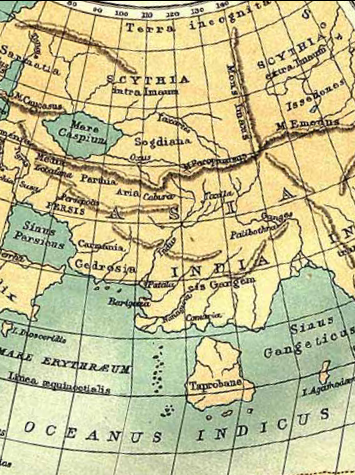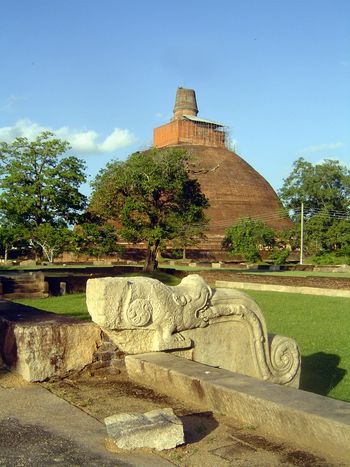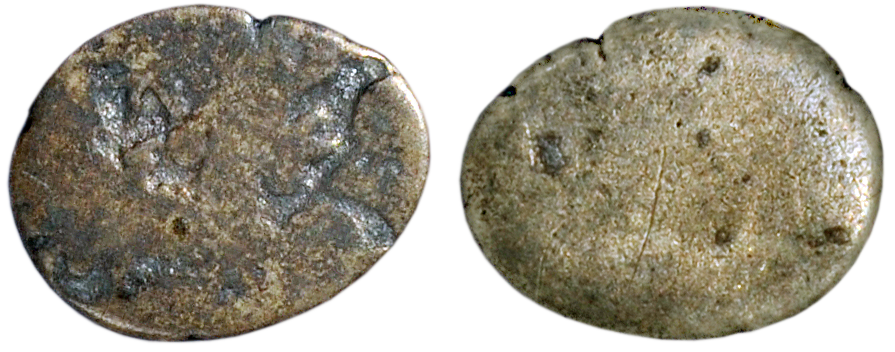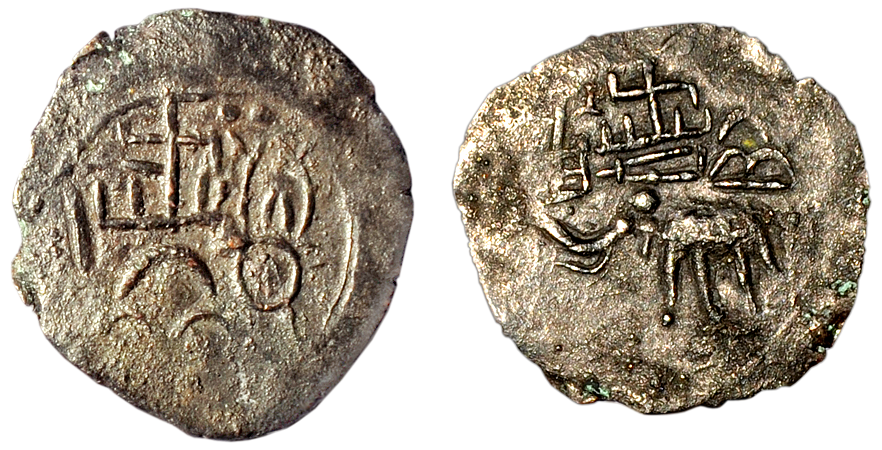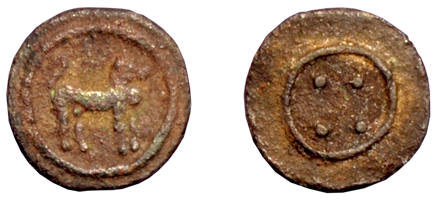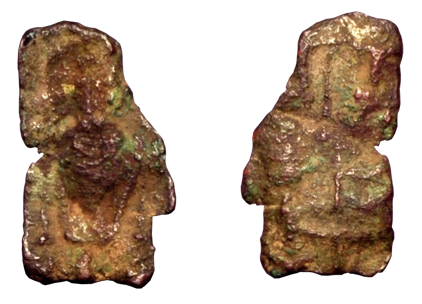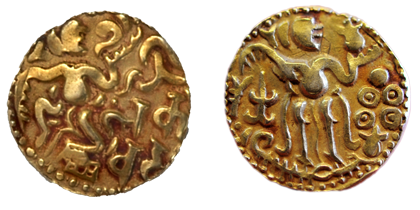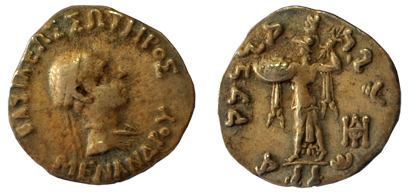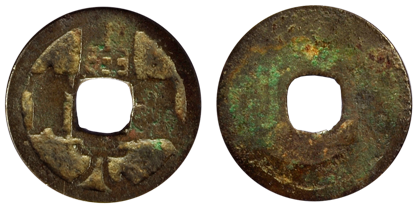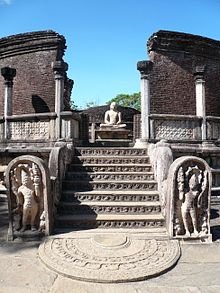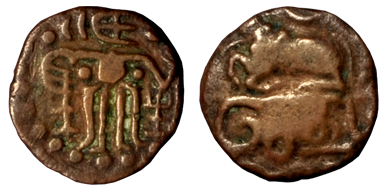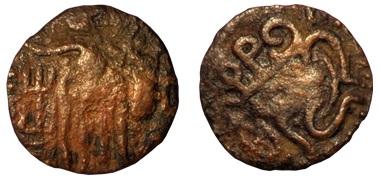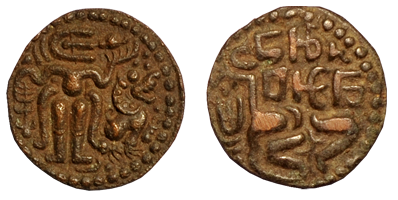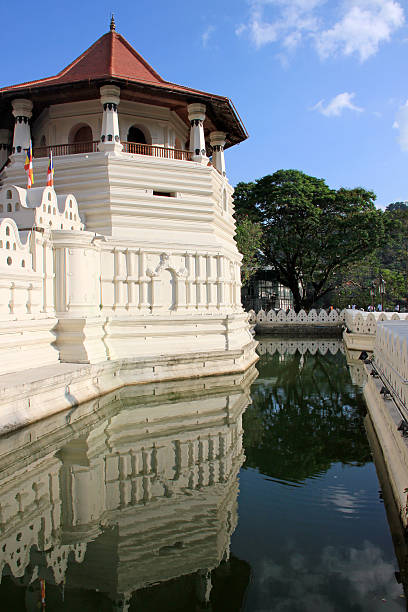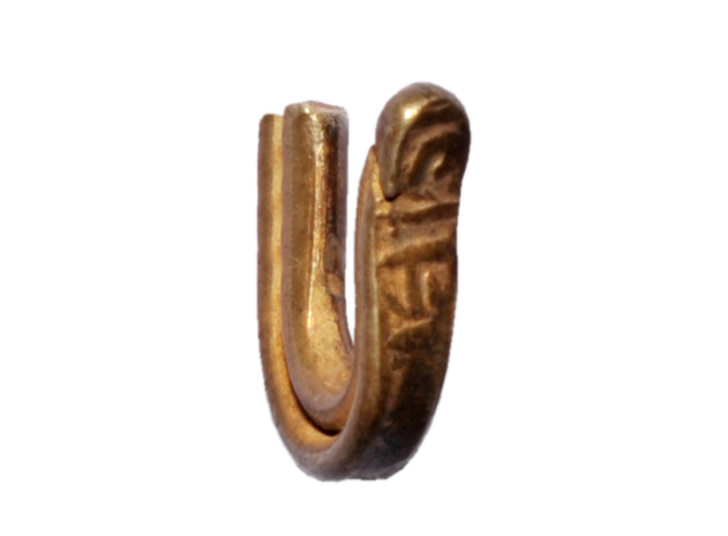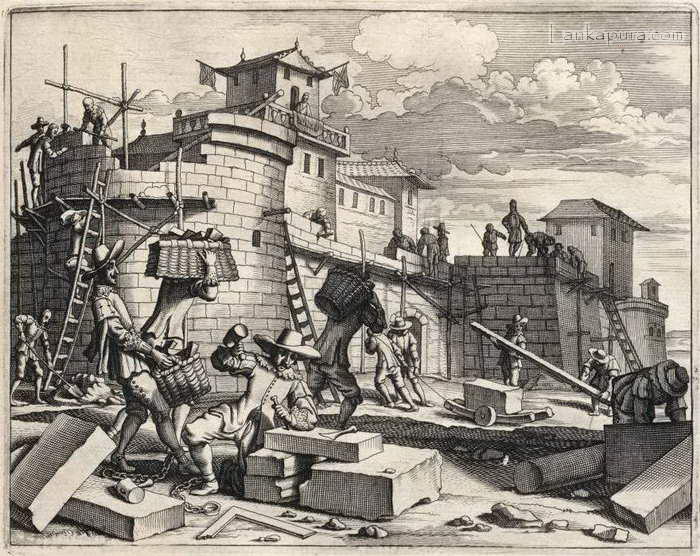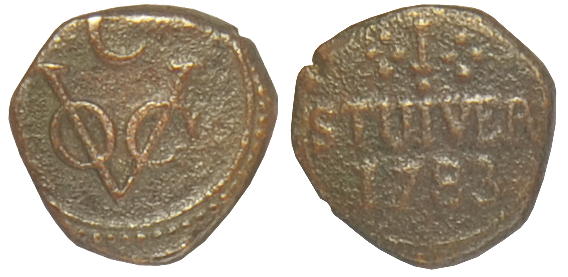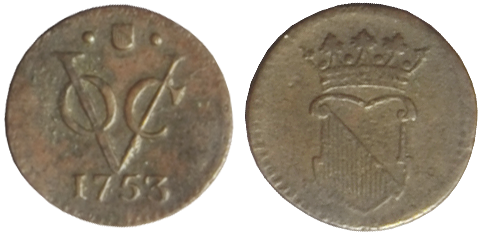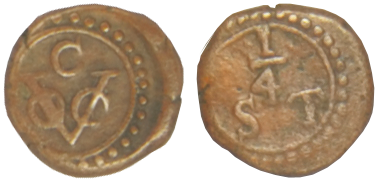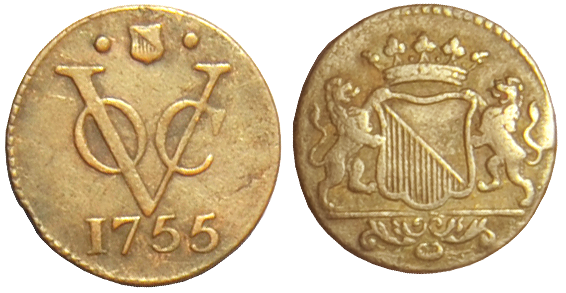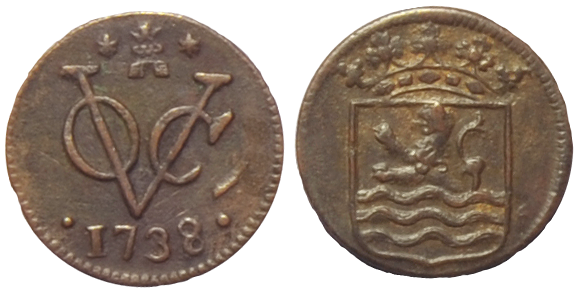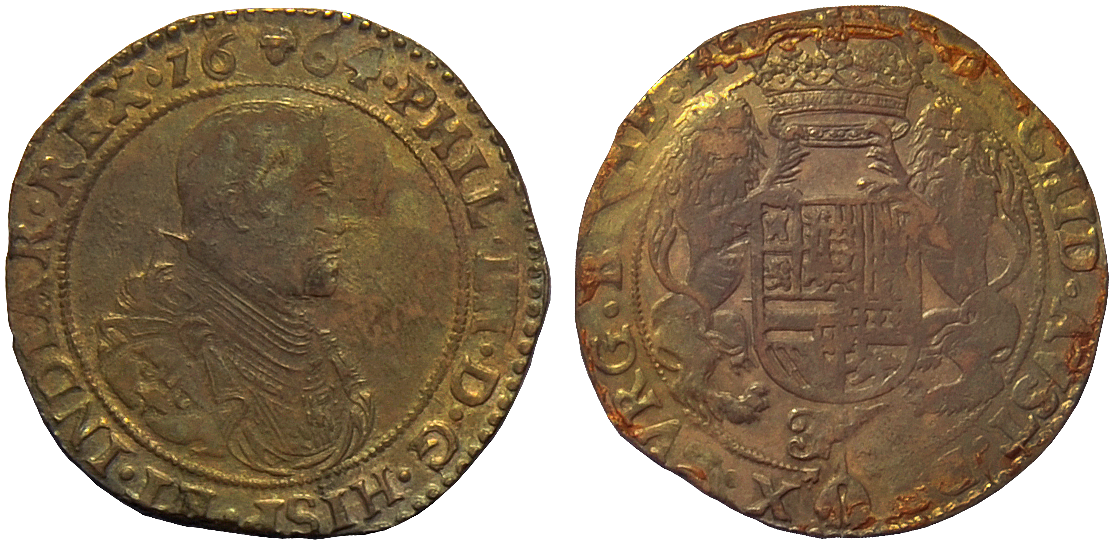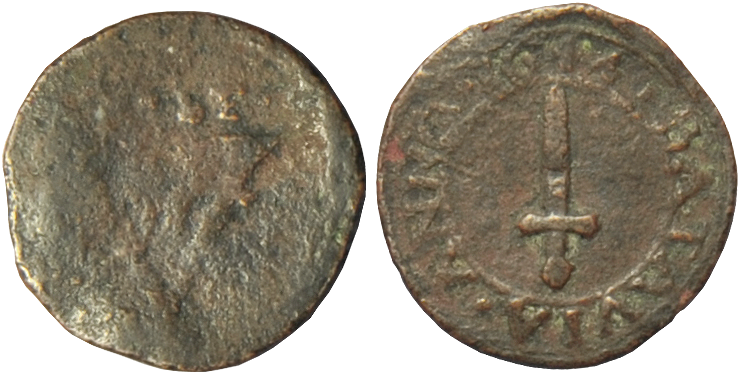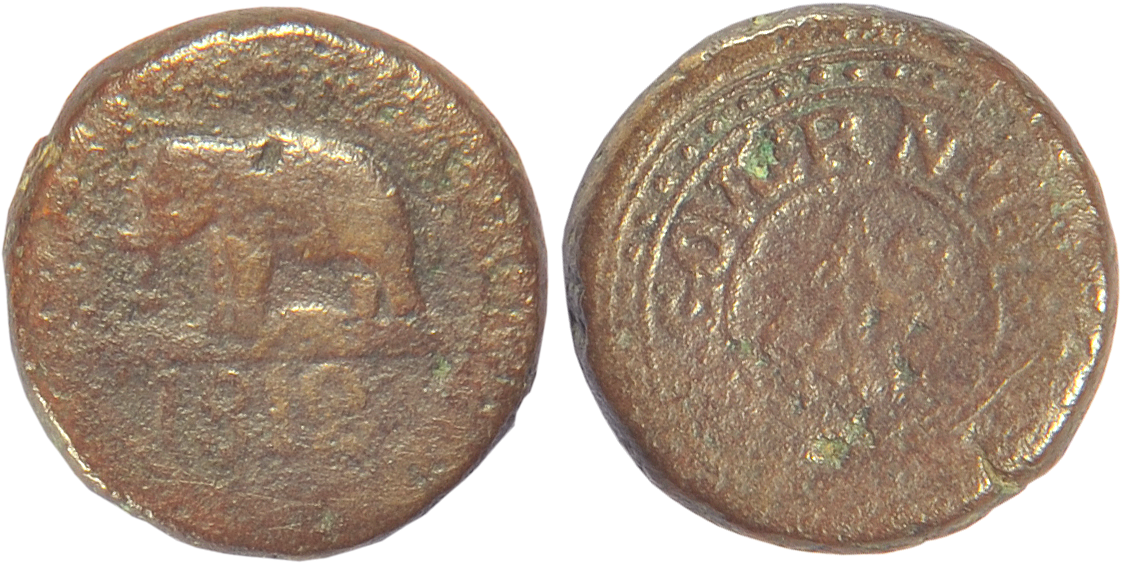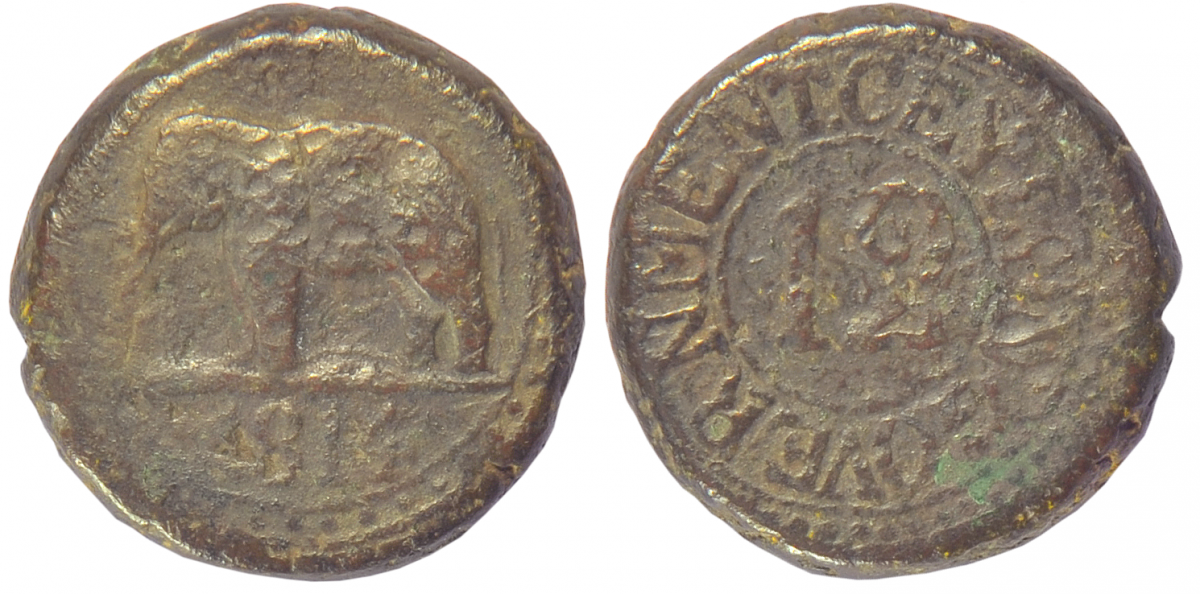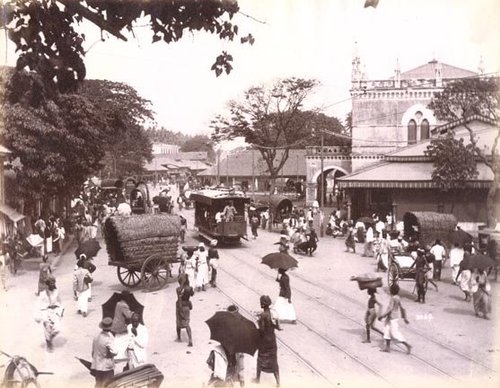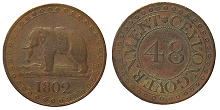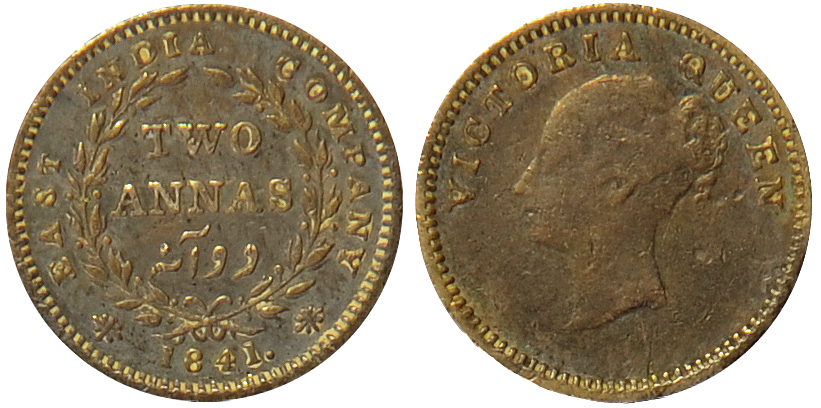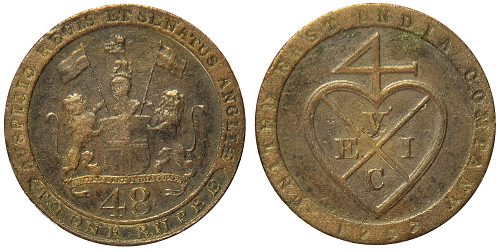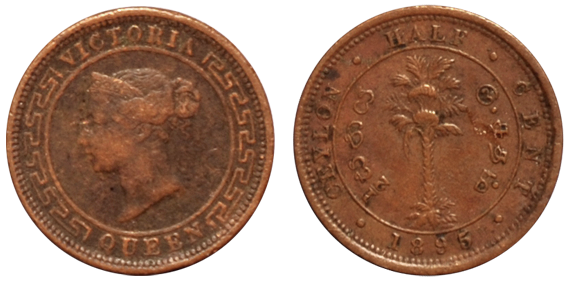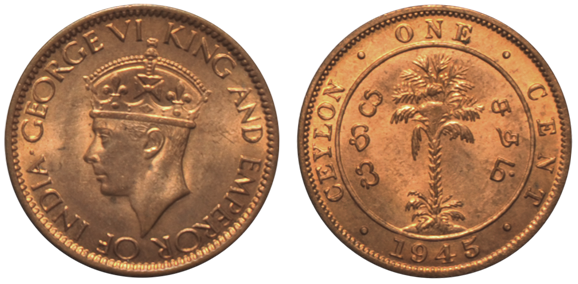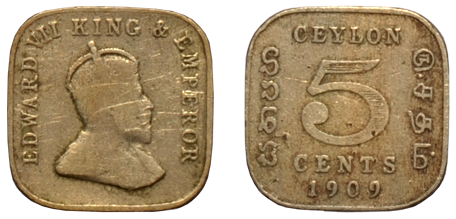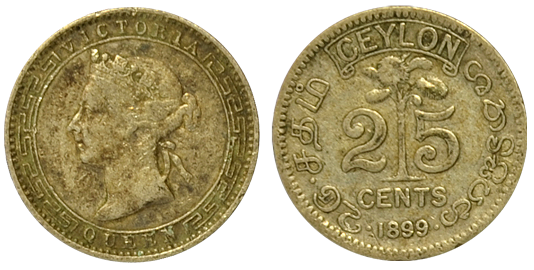History of Currency in Sri Lanka
Sri Lanka is a country with a long history and a similarly long and rich economic history. A study of that history will doubtlessly prove fruitful not only for economists but for everyone in the society. Coins used through different time periods of a country play an important role when studying the history of that country. Although small in size, a coin has the ability of giving a wealth of information about the economic and cultural history of the country where it was used, through signs that remain on them.
Why does Sri Lanka appear Magnified on Ptolemy’s world MAP ?
|
Extract of the world map by Ptolemy |
The image depicted here is an extract from the world map by Ptolemy who lived in 150 A.D in Rome.The map is drawn to considerably precise longitudinal and latitudinal coordinates. However, despite his accurate depiction of the Mediterranean, Europe and the Middle Eastern regions on the map; Sri Lanka appears significantly over-sized. This is no coincidence. It illustrates the recognition Sri Lanka had in the eyes of the world before and during Ptolemy’s time. Although it is small in length and width, the world as a whole considered Sri Lanka to be of great worth. In the past, Sri Lanka managed to garner the attention of the world partly due to the fact that it was uniquely placed at the center of the Silk Road that spanned from Far East Asia to Europe. It was also a doorway to entering the Overland Silk Road. Traders and explorers from the East and West would converge on this island. Sri Lanka functioned as a trading center for these travelers. There are Greek, Roman and Chinese texts that include a multitude of information that serve as testament to this. These facts reveal the Economic history of Sri Lanka. Upon close inspection of the great irrigation projects of those times, it becomes clear that the disciplines of engineering and agriculture were highly developed in Sri Lanka. The island also had an efficient trading system in place. |
Information detailing these endeavors can be found in epigraphs, ‘Vansha Katha’ (Chronicles of Dynasties), ancient texts and letters as well as in archeological evidence. Coins and epigraphs have a special place among this evidence. Being primary pieces of evidence regarding the economic history of Sri Lanka, these coins and epigraphs can be found in large numbers scattered across the island. Aside from local sources, afore mentioned records by international traders and foreigners also provide information about the trade mechanisms of Sri Lanka’s past. This information is extremely advantageous in the attempt to construct a timeline for the history of Sri Lanka’s economy.
Sri Lanka’s currency-use can be divided into following periods.
- Anuradhapura Era
- Polonnaruwa to Kotte Era
- Kandy Era
- Colonial Era
- Post-Independence Period since Establishment of the Central Bank of Ceylon
Anuradhapura Era
Coins used in Anuradhapura EraKahapana Swastika coins Maneless Lion coins Lakshmi Plaques Kahavanu or Lankeshvara coin Foreign Coins |
Anuradhapura Kingdom (377 BC– 1017AD)The Anuradhapura Kingdom named for its capital city, was the first established kingdom in ancient Sri Lanka. Founded by King Pandukabhaya in 377 BC. Epigraphs reveal a multitude of Information about trade and currency use during the Anuradhapura era. These records suggest that the production and distribution of coins were done systematically. At the time, the director in charge of coin production was known as “Rupadaka” (Periyakada Vihara Epigraph). The official who authorized the produced coins was known as “Rupawaapara”. (Kaduru Wewa Epigraph) |
|
Kahapana Kahapana Plaques |
The earliest unit of currency known in the island is referred to as a Kahapana. They are called puranas in Sanskrit and eldings in English. They are commonly known as punch marked coins, due to the marks or symbols that had been struck either on one side or both sides of the coin. Kahapanas are reckoned to have been produced by cutting strips of metal from hammered sheets. The known coins have been of many shapes, such as round, square, rectangular or oblong. Their weight had been adjusted by clipping the corners. The metal of the Kahapana has been found mostly to be silver.
|
Accordingly, the coins authorized by the King carried the Royal stamp. When these coins passed from one to another, various unique markings were added by each owner. As a result, these coins bear a multitude of different symbols. One particular coin contains 20 such markings which include the sun, the moon, a tusker, a dog, and a tree. It has been determined that over 500 unique markings were used on the ‘Kahapana’ coins. It is believed that these coins were initially produced in India and not in Sri Lanka. Due to international trade, these coins reached Sri Lanka via Indian vendors. Consequently, based on these coins, Sri Lanka produced its own ‘Kahapana’.
The ‘Kahapana’ had been in use in Sri Lanka from 3rd century B.C. to 1st century A.D. Anuradhapura, Tholuwila, Wessagiriya, Sigiriya, Bunnapola, Dedigama, Minuwangoda, Udawalawe, Ambalangoda, Tissamaharama, Vallipuram, Kantharodai, Jaffna, Mulativu, Maanthota, Padaviya, Trincomalee are some of the many places where this type of coins have been found.
Swasthika CoinsApart from the ‘Kahapana’ coin with its many markings, other types of coins were also used during the Anuradhapura era. The tusker and swastika coin is one such type. It is a small Copper coin. A chosen few markings that occasionally appeared on the ‘Kahapana’ were added in the making of this particular coin. |
Tusker and Swasthika Coin |
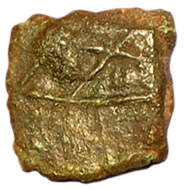 Bodhi Tree and Swasthika Coin |
Bodhi Tree and Swasthika Coin |
On one side of the coin, there is an image of a walking tusker, a stupa drawn using three half moons, a swastika and a Bo tree with three branches inscribed in a square. On the flipside, there is a swastika, a trident and a stupa. However, when considering the coin as a unit of currency, it is probable that it was in the same category as a ‘Kahapana’.
Maneless Lion coins
Maneless Lion coins |
This is a Copper coin. On one side, there is an image of a lion. On the other side, there are three or sometimes four dots. It is likely that these dots indicate the value of the coin. The diameter of this coin is between ½ - ¾ inches and it weighs between 15-40 grains. These coins were used from 3-4 A.D. The coins have been found during excavations in Anuradhapura and the Northern regions of the island. |
Lakshmi PlaquesCoins with a female figure carved into the face were first circulated in Sri Lanka as early as 3 B.C - 8 A.D. It is believed that the woman on the coin is the goddess Lakshmi. Because of this, the coin is known as the ‘Lakshmi Thahadu (metal sheet)’. These coins were produced in two ways: the coins were either plated or engraved pieces of Copper. They also came in different sizes. The plated kind were 1 ¼ inches in length and ½ inch in width. The coins are a mixture of approximately 60 percent Lead and 15 percent Copper. |
Lakshmi Plaques |
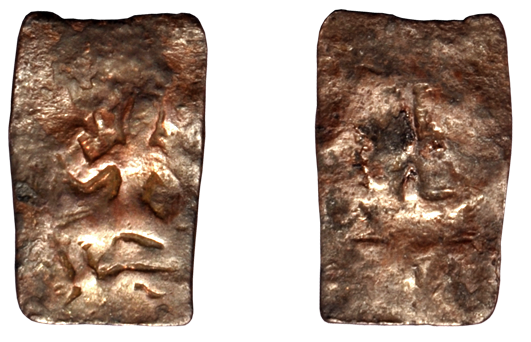 |
On the coin face, the goddess Lakshmi is standing on a lotus flower grasping two lotus stems that are protruding from either side of the flower. The stems, which reach her shoulders, each carry a blossomed lotus flower upon which stands a tusker holding a clay water vase. The image depicts the goddess bathing in the water pouring out of the vases held by the two tuskers. In some versions of this coin, goddess Lakshmi is shown seated on a lotus flower.
The Lakshmi coins have been found is such places as Anuradhapura, Jaffna, Wallipuram and Thirukethiswaram as well as Kantharoda, Mannar, Mulativu, Chilaw and Thissamaharama.
Kahavanu or Lankeshvara coinsA Sinhalese gold coinage known as the 'Kahavanu" had been in circulation in the island from about the 7th to 8th centuries AD. These coins were either gold or gold-plated. They were distinguishable in terms of value as ‘Kahawanu’, ‘Ada Kahawanu’, ‘De Aka’ and ‘Aka’. On the face of the coin there is a human figure standing on a lotus stem. The figure appears to be clad in something similar to a ‘Dhothi’. The figure’s upturned left hand is holding an object against his tilted face. Some believe that the figure is ‘Kuwera’ the God of Wealth. There is a conch and Lotus flower on the flipside of the coin. There are various opinions about these images. However, these coins can be grouped based on the object the figure is holding in his left hand; Sun and moon, Trophies, Lotus flower and half moon, Jasmine bud and lotus flower, Globe and bangle, Jasmine flower and conch. |
Kahavanu |
|
Foreign Coins to AnuradhapuraClear proof that Sri Lanka was a functioning naval base in the past comes from the foreign coins used during the Anuradhapura era. A great number of Greek, Roman, Chinese, Arabic and Indian coins used in international trade were found in Anuradhapura, Mihintale, Sigiriya, Kurunegala, Matara, Akurugoda and Badulla. |
Indo - Greek Coin |
||
 Pallawa Coin |
 Sasanian Shapur Coin |
 Kushan Coin |
|
|
Roman Coins Several types of Copper Roman coins were used in Sri Lanka. These coins were minted in Rome. The fact that these coins were found all over Sri Lanka indicates that they were widely in use at the time. Majority of these coins belong to the 4th and 5th centuries A.D. This implies that a great deal of trading occurred between the Roman Empire and Sri Lanka. Additionally, due to high circulation and consequent ware and tare, these coins have a tattered appearance. |
Roman Coin - 1 |
Roman Coin - 2 |
||
|
In addition to the coins that were acquired through international trade; it appears that Roman coins were also minted in Sri Lanka. A large number of such coins were discovered in Navimana, Matara. A number of Roman coins of which some were minted in Rome as well as in Sri Lanka were found in archeological excavations in Sigiriya and Anuradhapura. The main difference between these two types of coins is that the locally produced coins are missing an English character that can be seen on the coins minted in Rome.Instead of the English character, the locally minted coins bear a number ofshort lines arranged in different shapes. |
||||
|
Chinese Coins These coins are made of Copper or Copper-rich alloys. Coins minted in different eras are different in size as well. The coins are circular with a squareshaped hole in the center. The Chinese Emperor’s name is engraved in Chinese calligraphy along the four sides of the square. There are no markings or images on the flipside of the coin. |
Chinese Coin - 1 |
 Chinese Coin - 2 |
||
Arabic Coins
These coins are minted using metals such as copper and silver. On the face, there are devotional phrases in Arabic. The year of issue is inscribed on the flipside.
Polonnaruwa to Kotte Era
Coins used in Polonnaruwa to Kotte EraMassa Coins Dambadeni Coins / Coins of the Middle Ages Lion Coins Cetu Coins |
Polonnaruwa Kingdom (1017 A.D.–1057 A.D.)The period covers the kingdoms of Polonnaruwa 1017-1070, 1070-1232, Dambadeniya 1232 – 1272, Yapahuwa 1272-1293, Kurunegala 1293-1340, Gampola 1341- 1374 and Kotte (Sithavaka 1521-1593) 1372-1597. Kings of Chola dynasty that ruled from 1017 – 1070 A.D, issued a “Kahawanu” that was similar to a “Kahawanu” that was minted in the last half of the Anuradhapura era. It was made of copper. A unique characteristic of these coins was that each one bore the name of the king in power at the time of its production. This was the first coin produced in the country that bore the name of the ruler.
|
|
|
The names of the Kings in the Coins are:
|
Massa Coin - 1 |
Massa Coin - 2 |
Massa Coin - 3 |
|||||||||||
|
Massa Coins King Vijayabahu I who was responsible for toppling of the Chola dynasty, uniting the country and the inception of the Polonnaruwa Kingdom; also produced ‘Kahawanu’. He added his name to the face of the coin. Thus he is the first Sinhalese King to have had his name engraved on coins that were issued during his reign. This coin was known as ‘Massa’. The practice of engraving the name of the King on coins continued from the beginning of the Polonnaruwa era until the end of the Dambadeni era. The coins that belonged to the period of the Polonnaruwa Kingdom bore the name of the King responsible for their production in ’Naagari Akshara’ or ‘Naagari characters’. Thus the name of King Vijayabahu appeared on the coin as Sri Vijayabahu, King Parakramabahu as Sri Parakramabahu, Chodaganga as Sri Chodagangadeva, Queen Leelawathi as Sri Raja Leelawathi, King Sahassamalla as Sri Sahasamalla, Dharmashoka as Sri Dharmashokadeva, and Bhuwanekabahu as Sri Bhuwanekabahu. But King Nishankamalla’s name appeared as Sri Kaligalakeja. When names of kings Vijayabahu and Parakramabahu appear on coins, there is no specification as to which Vijayabahu or Parakramabahu it was. Only the name appears in same way in Naagari letters. In particular, Queen Leelawathi was in power in three different periods but there is no way of knowing which coins bearing her name came from which of the three periods. Coins produced under Chola kings such as Rajaraja I (985-1016 A.D), Rajendra I (1012-1044 A.D) and Rajadhiraja I (1018-1054) as well as under Pandya Kings were used during the Polonnaruwa Era. In addition, the use of coins minted under the kings of the Chinese Sun dynasty as well as the use of Arabic coins during this era indicates that Sri Lanka engaged in international trade in the Polonnaruwa era just as it did in the Anuradhapura era. |
||||||||||||||
Dambadeni Coins / Coins of the Middle AgesThe names of the Kings in the Coins are:
|
Lion Coin – Parakramabahu VI |
The golden ‘Kahawanu’ was a product of the last stages of the Anuradhapura era. The ‘Kahawanu’ entered the Polonnaruwa era in the form of a Copper coin. Nonetheless, coins that were used from the beginning of the Polonnaruwa era to the Dambadeni era are identified as the ‘coins of middle ages’ or Dambadeni. The ‘Dambadeni Massa’ coin is in fact the same as the Massa minted in the Polonnaruwa era. It is also known as the ‘Sinhala Massa’. |
||||||||
|
The images depicted on the faces of these coins are very similar to the ones found on coins from the Anuradhapura era. On one side of the coin there is a figure of a man clad in a ‘Dhothi’. The Copper Massa bears the same image. On the flipside, there is a figure seated. Additionally, there are other markings and symbols on both sides of the coin. Lion Coins A special feature can be observed on coins bearing the name of King Parakramabahu VI (1412 – 1467 AD). To specify, there is an image of a lion to the right of the human figure that appears on the face of the coin. These coins are known as ‘Lion coins’. This particular type of coin is the last of the ones bearing the names of the rulers. Cetu Coins The Cetu was issued in the 13th century under the rule of king Aryachakravarthi who ruled in Jaffna. This coin is a close imitation of the Dambadeni Massa. There is an image of a cow on one side and a standing figure (similar to that on the Dambadeni Massa) on the other. This coin is made of Copper. Majority of these coins were discovered in areas such as Nalloor, Thinnaveli, Kopai, Sandilippai, Sunthoor, Nagarkovil and Maamkulam. |
||||||||||
Kandy Era
Coins used in Kandy EraAngutu Massa/Koku Coins/ Laarin Dambadeni kasi Salli Indian ‘Waragama’ Tuttu Panama Tangama |
Kandyan Kingdom (1474 A.D. – 1815 A.D.)Kandy was the last capital of the Sinhala monarchy. Kandyan Kingdom which was founded about 1474, remained an independent kingdom until the “Hill Country Agreement” dated March 2nd, 1815 was signed transferring Sri Lanka’s autonomy to the British. The Portuguese and Dutch established in the maritime areas in the 16th – 18th Centuries i.e. during Kandyan era. According to historical texts, a few different types of currency were in use during in the heyday of the Hill Country Kingdom also known as “Sinhale”.
|
|
|
In the 10th century, a gold coin known as ‘Masuran’ was used in transactions. Because gold is a rare and precious metal, the ‘Masuran’ gradually went out of use. Therefore by the 13th century, the term ‘Masuran’ referred instead to a type of copper coin. |
Waragama Coin |
Silver Larin - 1 |
Silver Larin - 2 |
|
|
By the end of the 16th century, two types of Silver coins ‘Ridi (Massa)’ and ‘Panama’ came into use. But by this time, the gold coins ‘Ran Panam’ and ‘Ran massa’ were somewhat already in use. Later the ‘Thangam Massa’, ‘Podi (small) Thangama’, ‘Ridiya’ came in to use. In the 18th century, the Indian ‘Waragama’ was utilized in Sri Lanka. Around the same time, the copper coin ‘Salli’ was also used for transactions. One ‘Ridiya’ was worth 64 ‘Salli’ coins. Another contemporary coin was the Dutch ‘Stuiver’ which was used in the Hill Country Kingdom. The people of Sinhale called these coins ‘Thuttu’. Source: “Udarata Maha Keralla” – Professor Tennakon Wimalananda. In addition, a large variety of coins such as Larin, Dambadeni coins and Thangama were in use during the Kandy era. Angutu Massa coin was in use during the Kandy and Kotte periods and had a silver finish. It is believed that these hook-shaped coins were brought to Sri Lanka by vendors from Persia. These Persian coins were also known as “Laarin”. Records of Robert Knox’s experiences in Sri Lanka mention that these coins were minted and circulated by Kings of the Kandy era. |
||||
Colonial Era
Even though we divided Sri Lanka’s past into eras such as Anuradhapura, Polonnaruwa and Kandy; in all those eras, the entirety of Sri Lanka was never governed by one King. In different instances, the island was invaded by foreign powers. However, until the Kotte Era, the only invaders were the Chola. Despite such instabilities, we were able to make profits through international trade (via the Silk Road), win praise and maintain our splendid international reputation. But in 1453 A.D, the situation changed as a consequence of the fall of Constantinople (Capital of the Byzantine Empire). Europeans began to seek a route to the East over the great ocean. Eventually, the Europeans were victorious in the East and the West. As a result, Sri Lanka was colonized by the Portuguese, the Dutch and the English respectively.
Coins used in Portuguese Period
|
Portuguese Period (1505–1658)In 1505, the Governor and Viceroy of the Portuguese State of India was Don Francisco de Almeida. His son was Lorenzo de Almeida. He was in the process of attacking and thieving Muslim ships. The common belief is that Lorenzo de Almeida and his team were caught in a storm while pursuing a group of Muslim ships and were consequently washed ashore somewhere near Galle, Sri Lanka. But it is hard to believe that the avaricious Portuguese of that time turned their attentive eye towards the prosperous trade center that was Sri Lanka only after such a coincidental happening. The Portuguese took control of the coastal areas of Sri Lanka in 1505 A.D. and then from 1506 – 1658 a few different types of coins were minted and circulated. |
|
|
Malacca The Portugal Coat of Arms appears on one side of the Malacca coin. On either side of the seal the letters AM, MA or DM can be seen. AM is the abbreviation for Asian Malacca. Similarly, MA and DM are abbreviations for Malacca and De Malacca respectively. To indicate that it is Thangam;, the letters A and T appear superimposed on the flipside of the coin. On the same side, the year of production is also stated. The Portuguese minted some of these coins in Goa specifically to be used in Sri Lanka. These particular coins have the Portuguese Coat of Arms flanked by the letters GA on one side and the letters DS (superimposed) on the opposite side. DS is an abbreviation for ‘De Seylao’ which was the term used for Sri Lanka. Gini Massa The coin ‘Gini Maessa’ is commonly known as ‘Gini Massa’. There is an inscription of a gridiron on its flipside. Therefore this coin should be known as “Gini Maessa” which means gridiron in Sinhala. The Portuguese landed on this island in 1505 A.D. Before their immediate departure, they had a small fortress constructed in Colombo in the name of Saint Lawrence. He had departed this life while burning on a gridiron. Therefore Gini Maessa coins were minted and issued in memory of his final moments. It is possible that this was the first commemorative coin issued by people of the West in Sri Lanka. Gini Maessa coins were issued as Thangama coins in 1640 and Dvi Thangama coins in 1645. Coins of Saints This series of coins bear the Portuguese Coat of Arms on one side (with GA imprinted on either side) and an image of a Saint on the flipside. Letters such as ST or SF are printed on either side of the image in order to indicate which Saint was being portrayed on the coin. These letterings represent Saint Thomas and Saint Filipe respectively. Aside from these, coins such as Crusado, Chakram, Panam, Larins as well as Gold Panam, Gold Pagodi and silver Panam were used during the Portuguese era. |
Coins used in Dutch Period
|
Dutch Period (1658–1796)In 1658 A.D, the Dutch drove out the Portuguese and took control of the coastal areas of Sri Lanka. First Batticaloa (in 1638), then Galle (in 1640), Colombo (in 1656) and finally Jaffna (1658) came under Dutch control. In 1638, after they acquired the Portuguese Fort, the Dutch made a treaty with King Rajasingha II (1635-1687). Section 14 of the treaty contains a multitude of rules regarding the use of money. According to the agreement, unless sanctioned by the King or the Dutch government, the acts of printing, producing publicizing, minting counterfeit coins or circulation was deemed illegal.
|
|
|
Duits The coin that was most commonly used in transactions of this period is the Duit. This is a type of very small Copper coin. Due to its size, it was very inconvenient to count large numbers of Duits during transactions. To lessen the inconvenience, in 1737, numbers of Duits were joined together to form strings or chains of Duits.For instance, when 8, 16 or 24 Duits were strung together they represented the values of 2,4, and 6 Thuttu respectively. However, this measure did not prove to be as successful as anticipated. In the 18th century, the Dutch began to mint their Thuttu coins in Sri Lanka. In 1781, the Ductch established the first coin minting factory and it was located near Kayman’s Gate in Colombo. Another Dutch coin that was being used in Sri Lanka is the Rix - Dollar. In Sinhalese, these were called Pathaga. The Rix – Dollar was a type of Silver coin. The Dutch also introduced the Silver one Rupee coin to Sri Lanka. They were minted in 1781 and 1786. On the face of the coin it said: The Colombo Dutch Company’s coin. On the Back of the coin “Lanka Island Currency” is stated in Arabic. The year of release also appears on the back. |
C Duit |
Half Hollandia Duit |
Half Utrecht Duit |
|
|
Hollandia Duit |
Quarter C Duit |
T Duit |
||
|
Utrecht Duit |
West Friesland Duit |
Zeelandia Duit |
||
|
Ducatoon |
Bathavian Mintage |
Ceylon Stuivers - 1 |
Ceylon Stuivers - 2 |
Ceylon Stuivers - 3 |
|
The First Bank Note Up until the last half of Dutch Sri Lanka, only coins were used in transactions. But in the final years of the 1700s, Dutch security expenditure increased exponentially. The expenditure vastly surpassed income and almost emptied the treasury. The birth of the banknote took place against this backdrop. So on March 19, 1785 banknotes equivalent to 25,000 Pathaga were authorized for printing. Accordingly, Sri Lanka’s first series of banknotes was issued on the 10th of May, 1785. The first notes had values equivalent to 50, 100, 500 and 1000 Pathaga. Afterwards, notes of 1,2,3,4,5,10 Pathaga were also printed. These notes contained the signatures of three government officials. |
Banknote equivalent to one 'Pathaga' |
Coins used in British Period
|
British Period (1796–1948)The French revolution resulted in a major shake-up among the European powers and in 1796 the Dutch were easily supplanted by the British, who in 1815 also won the control of the kingdom of Kandy, becoming the first European power to rule the whole island. But in 1802, Sri Lanka became a Crown Colony and in 1818 a unified administration for the island was set up. |
|
There are two types of coins the English used for transactions in Sri Lanka. The first was a gold coin minted in Madras known as ‘Tharaka Pagodi’ or the Star Pagodi. One Star Pagodi was the equivalent of 45 Panam or 180 Thuttu. The second type of coin was a Copper one. They were minted in England in 1794 and 1797. It was equivalent to 1/96 (gold coin) and 1/48 (copper coin) of a Rupee. ‘United East India Company’ was printed on one side with the year it was issued. The Royal Coat of Arms and the value of the coin could be seen on the other side of the coin.
|
481-1st Stiver |
Anna 2 |
48-1 Rupees |
Fanam Token |
Farthing |
|
They also issued ½ Thuttu and ¼ Thuttu coins in 1801. On one side of these coins there was an image of a tusker and the year it was issued. On the flipside, Ceylon Government is engraved along the edge while the value of the coin can be seen at the center. The value on the Thuttu is 48 and the value on the ½ Thuttu is 96. The value on the ¼ Thuttu is 192. These values illustrate the number of each coin needed to match a Pathaga. Multiple batches of these coins were minted between 1801 and 1804. |
 Pence |
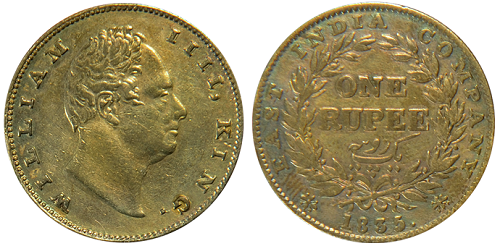 British Indian Rupee |
||
Like the Dutch, the English also issued banknotes in addition to coins. The first series was issued in 1800. Up until 1801, monetary quantities were recorded in English publications using the Star Pagodhi system. But this method changed after the areas under British control came under the Chief Secretary in charge of Colonial Regions. From then on, Pathaga, Panam and Thuttu were used in recording monetary quantities. Thus the ¼ Pagodhi became equivalent to 1 Pathaga. (1/4 Pagodhi=1 Pathaga)
From 1808 to 1818, ½, 1 and 2 Pathaga (silver) were minted occasionally and their values appeared on the coins as 24, 48 and 96 respectively. In 1803-1817, the copper coins Panam, Thuttu and Thuttu Deka (two Thuttu) were issued as well.
|
2 Cents - 1895 |
1 Cent - 1945 |
5 Cents - 1909 |
25 Cents - 1899 |
50 Cents - 1942 |
|
In the time of British – Sri Lanka, currencies such as Farthing, British Thuttu, Pathaga (Silver Coin), Panam, Indian Rupee, ½ Rupee and ¼ Rupee were in use. The cent, two -cent, five-cent, ten cent, twenty-five –cent and fifty –cent coins were also used as units that had values less than the Rupee. As a solution for colossal shortage faced in 1815, British took a large number of Duits (worth 37,339 Pathaga) confiscated from the Dutch and re-circulated them as their own currency. |
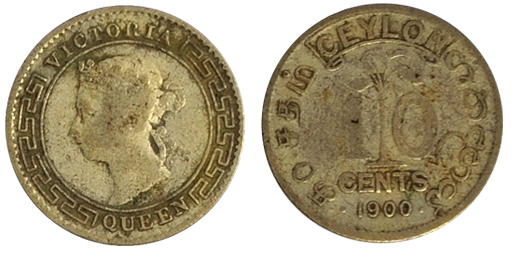 10 Cents - 1900 |
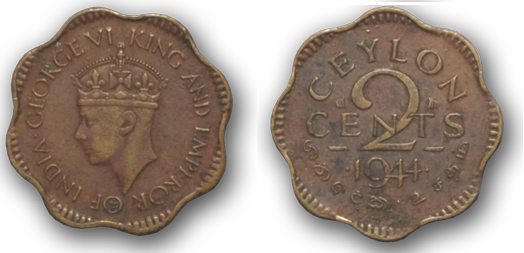 2 Cents - 1944 |
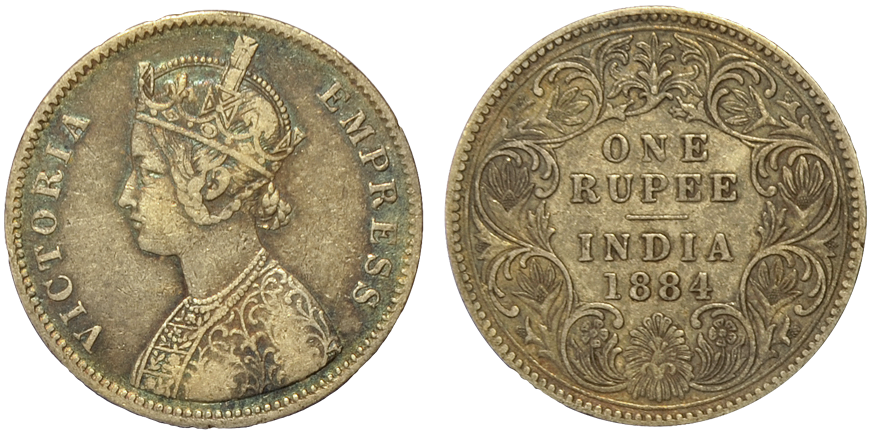 1 Rupee - 1884 |
|
During the British period, notes were issued by three authorities:
| 1. Notes Issued by the General Treasury (1827 – 1855) - Pound Notes One pound Two pounds Five pounds |
2. Notes issued by the Private Banks, namely, (1844 – 1884) (i) Pound notes |
| 3. Notes issued by the Board of Commissioners of Currency (Under Government of Ceylon) (1884 – 1950) The Board of Commissioners consisted of The Treasurer Colonial Secretary Auditor General |
Subsidiary Currency Notes
Under the provisions of the Emergency Powers Acts. 1939 and 1940 the Board of Currency was authorized to issue denominations below one rupee to meet the shortage of coins. The Board of Commissioners issued subsidiary notes for the values of 5 cents, 10 cents, 25 cents, 50 cents and 1 rupee. Of these notes, the 5 cents carried imprints of postage stamps of 2 cents and 3 cents.
In addition to these subsidiary notes, the Board of Commissioners issued notes worth 1 rupee, 2 rupees, 5 rupees, 10 rupees, 50 rupees, 100 rupees, 500 rupees, 1,000 rupees and 10,000 rupees. The 10,000 rupee currency note was used only for inter bank transactions.
Post Independence Period Since Establishment of the Central Bank of Ceylon
The Central Bank of Ceylon was established on 28th August 1950 in terms of the Monetary Law Act No. 58 of 1949. The Monetary Law Act provided for establishment of a Monetary Board to administer, among other functions of the CBSL, the issue of currency, which included both notes and coins.
Coins issued by the Central Bank of Ceylon
The notes issued by the British were used in Ceylon up to 1951 and the coins were used up to 1963. The first Sri Lankan coin series was introduced in 1963. The Emblem of Ceylon was introduced in the obverse of this coin series. This series consisted of coins in the denominations of:
| One cent (Aluminium) |
| Two cents (Aluminium) |
| Five cents (Brass) |
| Ten cents (Brass) |
| Twenty-five cents (Copper / Nickel) |
| Fifty cents (Copper / Nickel) |
| One rupee (Copper / Nickel) |
Rupees 5 (Nickel / Brass) and Rupees 2 (Copper / Nickel) circulation coins were introduced in 1984 instead of the five rupee and two-rupee notes.
In 2005, the Central Bank issued a new series of circulation coins of Rs.5 and Rs.2 by changing their weight and alloy, while Re. 1, Cts.50 and Cts.25 coins were issued by changing the size, alloy, weight and colour.
A new 10 Rupees circulation coin was introduced to the existing coin series in 2009. The coins were made of Nickel Plated Steel with the shape of 11 lobed.
In 2016, the metal of 1 Rupee and 5 Rupees coins were changed to Stainless Steel from Brass Plated Steel, considering the long lifespan and lower cost. Additionally, the Edge Letterings were removed in the 5 Rupees coin to reduce costs further.
In 2017, a new series of circulation coins was introduced with face value of Rs.10, Rs.5, Rs.2 and Re.1 (Stainless Steel – AISI 430) with objectives of reducing the cost of coins minting, increasing the durability of coins, giving more portability, and identifying easily by visually impaired people. Accordingly, the size, weight, shape, edge, and design of all four coins were changed, reflecting a progressive pattern of diameter and thickness. These new coins are circulating along with the previous issued coins.
Eleven series of currency notes issued by the Central Bank of Sri Lanka since 1950 are as follows;
| Theme | Denomination (Rs) |
Year | |
| 1 | King George VI series | 1 and 10 | 1951 |
| 2 | Queen Elizabeth II series | 1, 2, 5, 10, 50 and 100 | 1952 |
| 3 | Armorial Ensign of Ceylon series | 1, 2, 5, 10, 50 and 100 | 1956 |
| 4 | S W R D Bandaranaike Portrait series | 2, 5, 10 ,50 and 100 | 1962 |
| 5 | King Parakramabahu the Great series | 2, 5, 10 ,50 and 100 | 1965 |
| 6 | Armorial Ensign of Sri Lanka series | 50 and 100 | 1975 |
| 7 | Fauna and Flora Series | 2, 5, 10, 20 ,50 and 100 | 1979 |
| 8 | Historical and Archaeological series | 5, 10, 20, 50, 100, 500 and 1000 | 1981 |
| 9 | Historical and Development series | 500 and 1000 | 1987 |
| 10 | Sri Lanka Heritage series | 10, 20, 50, 100, 500, 1000 | 1991 |
| 2000 | 2005 | ||
| 11 | Development, Prosperity and Sri Lankan Dancers series | 20, 50, 100, 500, 1000, and 5000 | 2011 |











